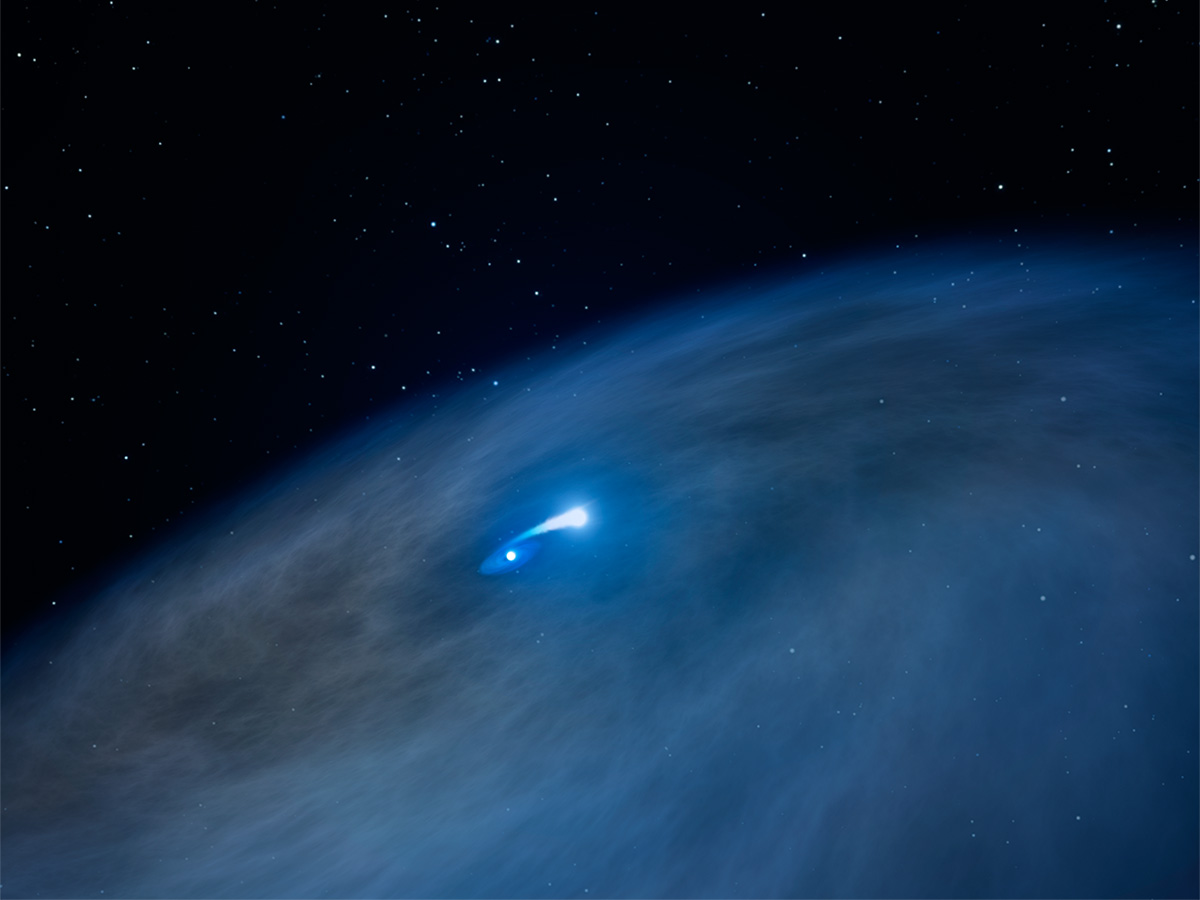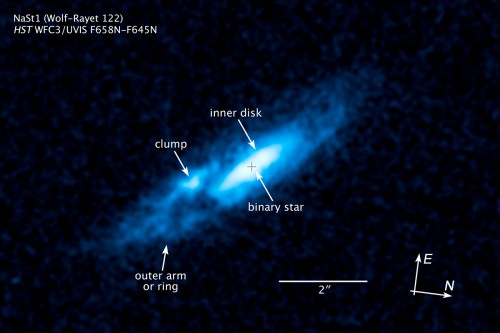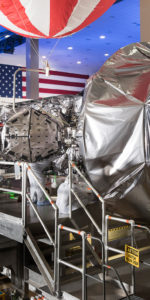
Biological diversity is a key defining characteristic of life on Earth, which determines the wide variety of all the closely intertwined and interconnected living organisms and ecosystems on our planet. A similar diversity of the stellar variety exists in the Universe as well, with many different stellar species populating the cosmic zoo, which are closely interconnected in a way that the evolution of each unique profoundly affects the rest as well. With the help of ground and space-based telescopes including NASA’s Hubble and the Chandra X-ray Observatory, astronomers have been recently given a unique view of a certain type of Wolf-Rayet star, which are some of the most prominent members of the galaxy’s population of very massive stars.
Wolf–Rayet stars are a peculiar breed in the galaxy’s stellar population, which represent the final evolutionary stages of very massive stars. With surface temperatures that can exceed 100,000 K and masses that can be more than 60 times that of the Sun, they are some of the hottest and most massive stars in existence. What makes Wolf–Rayet stars stood out from other types of supermassive stars, is the fact that they exhibit an extreme rate of mass loss through the outward flow of very powerful stellar winds that can reach speeds of several million km per hour. The driver of these powerful stellar winds is the intense radiation that is being emitted from their cores during the end of their lives, as a result of a series of runaway thermonuclear reactions which fuse ever heavier elements in a futile attempt to prevent the stars eventual collapse under the pressure of their own weight. Through this process, Wolf–Rayet stars can lose the equivalent of 10 solar masses of material in less than a million years, while enriching the interstellar medium with large amounts of heavy elements as they end their lives in spectacular and violent supernova explosions.

Even though Wolf–Rayet stars have been studied extensively since they were first discovered during the 19th century, a host of fundamental questions about their nature still remain. For instance, astronomers are uncertain about the exact mechanisms that drive these stars’ powerful stellar winds. Furthermore, their exact structure also remains unclear as well due to the fact that Wolf–Rayet stars are typically embedded in vast opaque dusty nebulae as a result of their ongoing mass loss, which greatly limits observations. Despite these difficulties, astronomers have managed to gain many important insights about these cosmic behemoths during the last several decades, with the help of space-based observatories which have studied these violent stellar objects in various parts of the electromagnetic spectrum. The latest such study comes from a US research team, which utilised NASA’s Hubble Space Telescope and the Chandra X-ray Observatory in conjunction with several state-of-the art ground-based telescopes, like the MagAO Adaptive Optics System at the Las Campanas Observatory in Chile. The researchers, who were led by Jon Mauerhan, an astronomer at the University of California, Berkeley, focused their studies on a peculiar Wolf–Rayet star located approximately 3,000 light-years away, named NaSt1, which they affectionately called ‘Nasty 1′.
The reason for this nomenclature has been some of the star’s strange properties that are very rare among Wolf–Rayet stars. More specifically, while observing NaSt1, astronomers expected it to exhibit a bipolar morphology similar to that of other stars of its kind like the famous Eta Carinae binary, which has been a favorite imaging target for the Hubble Space Telescope. Eta Carinae exhibits two big lobes of expanding material that rush away from the central binary star system at thousands of miles per second as a result of an extremely energetic explosion, creating a unique morphology as seen through telescopes. In contrast, NaSt1 was revealed by Hubble to be surrounded by an expansive 2 trillion miles-wide nebula that had an equatorial, pancake-shaped structure instead, that was more similar to that of WR 104, another unique Wolf–Rayet binary star that features a a spiral, pinwheel-like pattern of outflowing gas and dust. “We were excited to see this disk-like structure because it may be evidence for a Wolf-Rayet star forming from a binary interaction,” says Mauerhan. “There are very few examples in the galaxy of this process in action because this phase is short-lived, perhaps lasting only a hundred thousand years, while the timescale over which a resulting disk is visible could be only ten thousand years or less.”
Since more than half of all the known Wolf-Rayet stars in the galaxy have been found to be members of binary star systems, astronomers believe that these unique structures that have been observed on NaSt1 as well as on WR 104, are a result of the interplay between the two close stellar companions which lie at the center of the system. Nevertheless, the exact mechanism that give rises to the surrounding nebula of Wolf-Rayet stars is not currently understood. One leading hypothesis posits that as the stellar wind of Wolf-Rayet stars start to expel the latters’ hydrogen envelopes, they collide with the wind from their companions, resulting in the creation of the observed thick disks of dust. But the velocity of the stellar winds from NaSt1 was measured by Mauerhan’s team to be approximately 22,000 miles per hour – much slower than that of Eta Carinae and insufficient to be creating any large-scale outflow of hydrogen from NaSt1. An alternative hypothesis that has also been proposed is that of direct mass transfer between the two stellar companions. In this scenario, the matter that is slowly expelled by the Wolf-Rayet star, is eventually caught by its companion star. “We’re finding that it is hard to form all the Wolf-Rayet stars we observe by the traditional wind mechanism, because mass loss isn’t as strong as we used to think,” says Dr. Nathan Smith, an associate professor at the University of Arizona’s Department of Astronomy and member of Mauerhan’s team. “Mass exchange in binary systems seems to be vital to account for Wolf-Rayet stars and the supernovae they make, and catching binary stars in this short-lived phase will help us understand this process.” Nevertheless, this mass transfer process seems not to be that much efficient, with enough quantities of material eventually been left unabsorbed by the companion star, which then move on to create the Wolf-Rayet star’s surrounding nebula. “That’s what we think is happening in Nasty 1,” comments Mauerhan. “We think there is a Wolf-Rayet star buried inside the nebula, and we think the nebula is being created by this mass-transfer process. So this type of sloppy stellar cannibalism actually makes Nasty 1 a rather fitting nickname.”

One other important discovery by the researchers, was that the circumstellar disk around NaSt1 featured a bright knot of hot dust, indicating that it has formed very recently. Dust formation in particular near Wolf-Rayet stars was thought to be impossible, due to the fact that these star’s intense radiation and pressure would quikly destroy any nearby dust particles. Nevertheless, dust formation seems to be a regular process for these types of stars. “The dust in these systems is thought to be produced when a carbon-rich wind from a Wolf-Rayet carbon-rich star mixes with the hydrogen-rich wind of a less-evolved OB-type companion, creating chemistry suitable for the formation of graphite or silicates”, writes Mauerhan’s team in their study, which was published on the May 21 online edition of the Monthly Notices of the Royal Astronomical Society.
By their very nature, Wolf-Rayet stars are bound to a ‘live fast, die young’-kind of lifestyle. It is theorised that NaSt1 will dissipate most of its material in a spectacular supernova explosion, leaving its burned out core behind, during a process that is however not well understood at present. The continuing study of these mysterious stellar objects could thus help answer some long-standing questions regarding the final stages of stellar evolution. “What evolutionary path the star will take is uncertain, but it will definitely not be boring,” explains Mauerhan. “Nasty 1 could evolve into another Eta Carinae-type system. To make that transformation, the mass-gaining companion star could experience a giant eruption because of some instability related to the acquiring of matter from the newly formed Wolf-Rayet. Or, the Wolf-Rayet could explode as a supernova. A stellar merger is another potential outcome, depending on the orbital evolution of the system. The future could be full of all kinds of exotic possibilities depending on whether it blows up or how long the mass transfer occurs, and how long it lives after the mass transfer ceases.”
Originally thought to be single, most Wolf-Rayet stars were eventually found to be members of closely intertwined binary stellar systems. “Astronomers assumed Wolf-Rayet stars were single when trying to calculate how they evolve, but we are finding most have company,” says Dr. Debra Wallace, an astronomer at NASA’s Goddard Space Flight Center, Greenbelt, Md. “It’s like thinking married life will be the same as life as a bachelor. A companion star has got to change the life of these stars somehow.”
It turns out that just like humans, binary Wolf-Rayet stars can also exhibit nasty and unpredictable behaviors as well, through which many secrets of their tumultuous lives can be brought out in the open.
A description of WR 104, a Wolf-Rayet star similar to NaSt1. Video Credit: The History Channel
Be sure to “Like” AmericaSpace on Facebook and follow us on Twitter: @AmericaSpace




